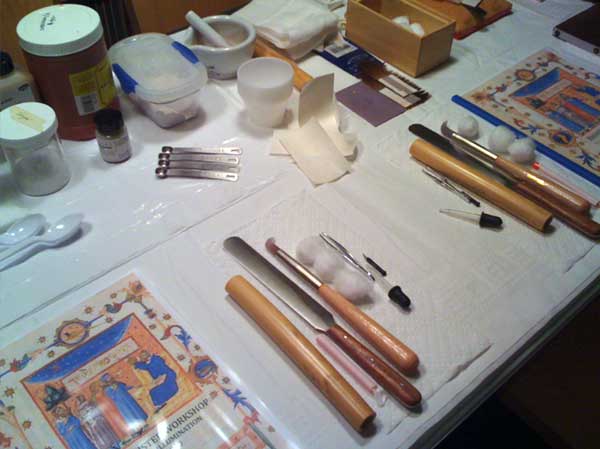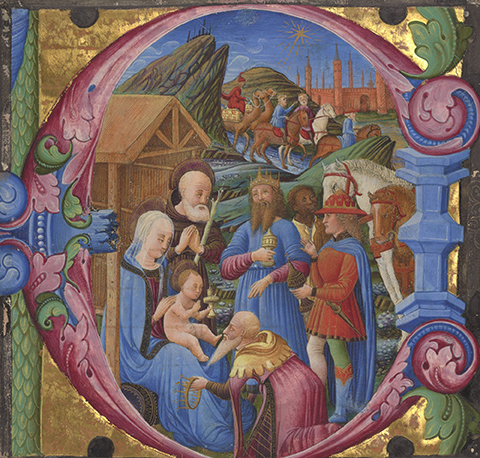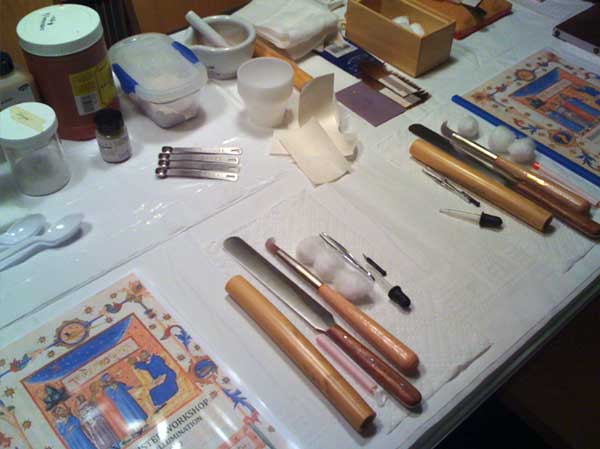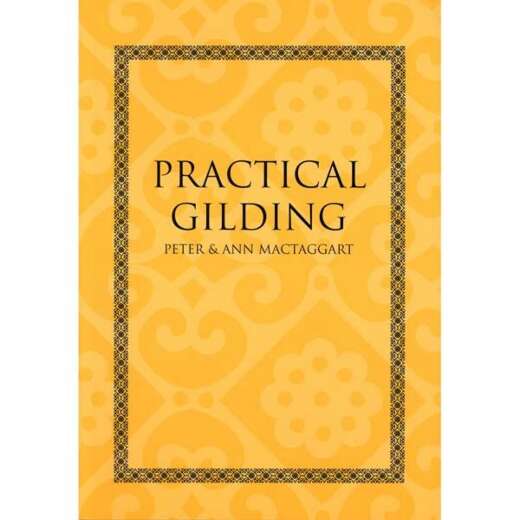
Master Class: Gilding for Illuminators
Friday, January 23, and Saturday, January 24, 2015
10:30 a.m.–5:00 p.m.
J. Paul Getty Museum; Museum studios
Limited to 12 participants. Class fee $235
A two-day Master Class will be offered by the J. Paul Getty Museum Department of Education and taught by artist Sylvana Barrett on Medieval and Renaissance gilding techniques as practiced by Manuscript Illuminators.
Gilded embellishments in texts have an ancient history stretching back into antiquity. Elaborate techniques developed during the Medieval Period became the standards by which gilding is judged today.

Cutting from a choir book, 1470s, Franco dei Russi. Tempera and gold on parchment. The J. Paul Getty Museum, Los Angeles, Ms. 83
Several historic treatises relative to the art of Manuscript Illumination have survived the centuries from the late medieval period. The usefulness of the information in these texts varies greatly, and most are compilations of recipes often gathered over time from unrelated sources primarily for pigment production. Still, many of these compilations also include information on gilding materials providing valuable insight into our understanding of techniques.
A few surviving treatises contain detailed practical instructions on techniques written by professional illuminators. For example, the anonymous 14th-century Italian text “De Arte Illuminandi” is a complete guide to the art of illumination and gilding written by a practicing illuminator. This text and others like it are invaluable to anyone wishing to master the art of gilding today. The workshop will utilize recipes from this and other 14th and 15th-century texts as a basis for understanding and mastering this art form.

Gilding tools and supplies used at the Master Class
Gilding, as practiced in the past, was a complex art. A thorough understanding of binders, fillers, clays, pigments, and additives allowed artists to manipulate their materials for desired visual effects. The workshop will introduce and familiarize contemporary gilders, accustomed to working with commercially prepared modern materials, with these historical alternatives.
Day one of the workshop will thoroughly review historic gilding materials. Participants will prepare materials for use and essential solutions from them as they are called for in the various recipes. Utilizing these materials, simple flat gilding techniques will be explored on day one.
Day two will focus on raised, burnished, and embellished gilding techniques which require complex mixtures of the materials prepared on day one. Many recipe variants survive for these mixtures, as their spectacular results were highly desirable.
The specific materials chosen for these complex mixtures affect the results and determine the techniques required. Participants will experiment with various mixtures to gain an understanding of this process. Recipes including fish glues or honey, for example, often result in mixtures that allow dry gilding technique, accomplished by breathing a very deep breath directly onto the preparatory layer from deep in the lungs and very quickly applying the gold leaf, while recipes relying on glair and glues must be re-wet for application of the gold.
Participants will prepare a sample page of gilding variations on parchment as a reference guide in selecting materials and recipes for their future artworks.
Participants are encouraged to bring works in progress. Historic gilding materials and techniques were initially intended for parchment use and can be adapted to paper. Previous gilding experience is recommended.
Workshop Information and Registration
The workshop will be held at the J. Paul Getty Museum in Los Angeles, California. It will coincide with the exhibition “Give and Ye Shall Receive: Gift Giving in the Middle Ages,” an exhibition drawn from the Museum’s spectacular collection of Medieval and Renaissance Illuminated Manuscripts.
Registration is through the J. Paul Getty Museum website: www.getty.edu
About the Instructor
Artist Sylvana Barrett has searched the sumptuous materials of Medieval and Renaissance paintings and illuminated manuscripts, learning to use them through historic treatises left by the artists themselves and producing original works with them.
As an artist and research collaborator with museum conservation institutes, she has made it a personal mission to share the knowledge gained with other artists through museum lectures and studio workshops in the hope that these beautiful materials will inspire others and find new life in contemporary works.
In addition to lecturing, she produces museum didactics for exhibition, has been featured in the award-winning film by the J. Paul Getty Museum, “The Making of A Spanish Polychrome Sculpture,” and a National Geographic’s Television production “How It Was: Secrets of Mona Lisa.” Speaking engagements include a TEDx event where she spoke on the topic of looking at paintings through the eyes of the artists who created them.
Current projects in production include an illustrated visual guide to the fourteenth-century artist’s manual by Cennino Cennini, “IL Libro dell’ Arte,” and the anonymous 14th-century Italian illuminators treatise “De Arte Illuminandi.”













